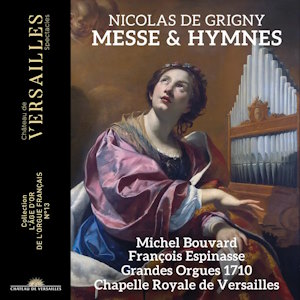
Nicolas de Grigny (1672-1703)
Premier Livre d’Orgue (1699)
Messe d’orgue
Hymnes:
Veni Creator
Pange lingua
Verbum supernum
Ave maris stella
A solis ortus
Michel Bouvard (organ)
François Espinasse (organ)
rec. 2024, la Chapelle Royale du Château de Versailles
Château de Versailles Spectacles CVS133 [2 CDs: 119]
Many will be amazed to discover from the accompanying liner notes to this 2 CD set that Nicolas de Grigny left to posterity only the music performed on this recording. His small but consequential compositional oeuvre was the result of his premature death in 1703, aged only 31. This untimely event deprived future generations of a great deal which his genius had to offer. His reputation rests solely on his Premier Livre d’Orgue, which is made up of a Mass and five Hymnes. Published in 1699, it is regarded as one of the greatest French organ works of its time. It certainly impressed J.S. Bach, no less, who copied it out entirely by hand for the purposes of study. Buxtehude, a near contemporary, also greatly admired the composer’s work. De Grigny was born into a family of musicians in Rheims in 1672, and studied with Nicolas Lebègue, a leading French Baroque composer, organist and harpsichordist. In 1697 he returned to his home city to become organist at the cathedral there. Two years later he wrote his Organ Book.
Renowned harpsichordist and musicologist Jon Baxendale credited Nicolas de Grigny as the “most erudite of Grand siècle organ composers”. Listening to these two discs, there’s so much variety in the music. In contrast to many of the other French organ composers around at the time, de Grigny’s music is more deep and probing in terms of its spiritual and emotional content. There are many startling contrasts, too. The opening Kyrie of the Mass is noble and splendid. The composer scatters some skilfully constructed five-part fugues throughout which Michel Bouvard delineates with precision and clarity. Every line can be heard distinctly. The Gloria’s Basse de Tompette ou de Cromorne has an uplifting spring in its step. Bouvard’s imaginative registration choices bring manifold colour to the proceedings. The Dialogue de Flûtes pour l’Élévation radiates a warm, luminous glow. The Ite Missa Est ends the Mass, as it began, with nobility and splendour.
François Espinasse performs the five Hymnes. These celebrate the church’s major feasts: ‘Veni Creator’ – Pentecost; ‘Pange lingua’ and ‘Verbum Supernum’ – Corpus Christi; ‘Ave maris stella’ – The Assumption; ‘A solis ortus’ – Christmas. Some recordings alternate sung chants between the organ settings, but this one doesn’t. If you are looking for a recording with both, then I’d recommend Serge Schoonbroodt’s cycle, if you can still find a copy, performed in Poitiers Cathedral (Etoile Production EP0001), in which he intones the chants himself. Espinasse’s splendid performance reveals the wonderful spectrum of colour this magnificent instrument provides. There are some thrilling organ sounds
Beautifully packaged, this two disc set is well-documented in French, English and German. I always find Château de Versailles Spectacles label’s production values very high indeed. The booklet provides an interesting overview of the Great Organ of the Royal Chapel, Versailles, including the essential organ specification details. The recordings are superbly engineered in performances that wholly capture the opulent acoustic of the Versailles venue.
Stephen Greenbank
Buying this recording via a link below generates revenue for MWI, which helps the site remain free




















